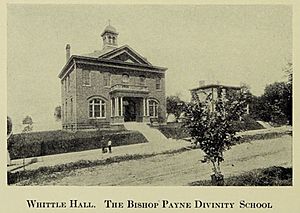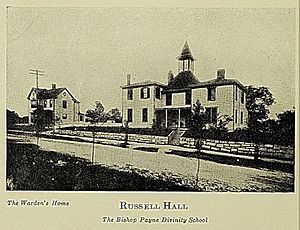Bishop Payne Divinity School facts for kids
Bishop Payne Divinity School was a special school in Petersburg, Virginia. It was for African-American students who wanted to become ministers in the Episcopal Church. At that time, many places, including schools, were "racially segregated." This meant Black and white people were kept separate by law and custom. The school operated from 1878 to 1949. Today, its Emmanuel Chapel still stands at the corner of South West and Willcox Streets.
School Buildings and History
The school started in 1878 because a student named James Solomon Russell wanted to become a minister. However, he was not allowed to study at the all-white Episcopal Virginia Theological Seminary (VTS) in Alexandria. To help him and other African-American students, a theology professor was added to an existing school called St. Stephen's Normal and Industrial School in Petersburg. This school helped freedmen, who were formerly enslaved people who were now free. Many of these students had very little education.
The theology professor's salary was paid by VTS. The school then became St. Stephen's Normal and Theological School. It was first located on Perry Street. For the first three years, James Russell was the only student studying to be a minister. By 1876, 20 students had joined.
In 1884, the state of Virginia officially recognized the school. It was named the Bishop Payne Divinity and Industrial School. This honored John Payne, who was the first Episcopal bishop of Liberia. Bishop Payne's widow even worked at the school as a matron. The name "Industrial School" was a bit confusing because the school didn't actually have an industrial department. Instead, it had a "Normal Department," which trained teachers.
From 1886 to 1889, the school was located on South Washington Street. In 1889, it bought land on South West Street. Here, they built two main buildings: Whittle Hall and Russell Hall, on opposite sides of the street. The school stayed at this location until it closed. Later, in 1902, the Warden's (head of school) home was built. Emmanuel Chapel was added in 1917. In 1910, the school's name changed again to Bishop Payne Divinity School. It was also given permission by Virginia to award a Bachelor of Divinity degree.
Students and Teachers
Bishop Payne Divinity School was the only school in the Episcopal Church that focused only on training young Black men for the ministry. By 1921, 91 students had graduated from the school. These graduates made up about 60% of all Black Episcopal clergy in the United States.
When it first started in 1878, the school offered high school level classes. In 1894, John W. Johnson, who graduated in 1890, became the first Black teacher at the school. Even after it could award degrees in 1910, the number of students was often small, usually only 12 to 15 at a time. In 1921, there were five professors, with four of them being white.
For many years, all the people on the school's board of trustees were white. But by 1947, seven out of seventeen trustees were Black.
The school faced challenges that made it hard to get students. One big issue was when the church's Diocese of Virginia decided not to let newly ordained Black ministers vote in the Diocesan Council. This made it harder for the school to attract students.
From 1905 to 1922, Corbin Braxton Bryan was the president. He held common beliefs of the time about racial separation, but he also believed it was important to offer the benefits of Christianity to Black students.
School Closure and Legacy
The last class graduated from Bishop Payne Divinity School in 1949. Just a few years later, in 1951, Virginia Theological Seminary (the all-white seminary) began to accept African-American students. Over its history, at least 256 Black men and 6 Black women attended Bishop Payne Divinity School. Not all of them graduated.
On June 3, 1953, the school officially closed. Its assets and records were moved to Virginia Theological Seminary in Alexandria, Virginia. A civil rights lawyer named Armistead Boothe helped with this merger.
Today, the library at Virginia Theological Seminary is named the Bishop Payne Library, honoring the school's important history.
Alumni
- George Freeman Bragg
- James Solomon Russell



